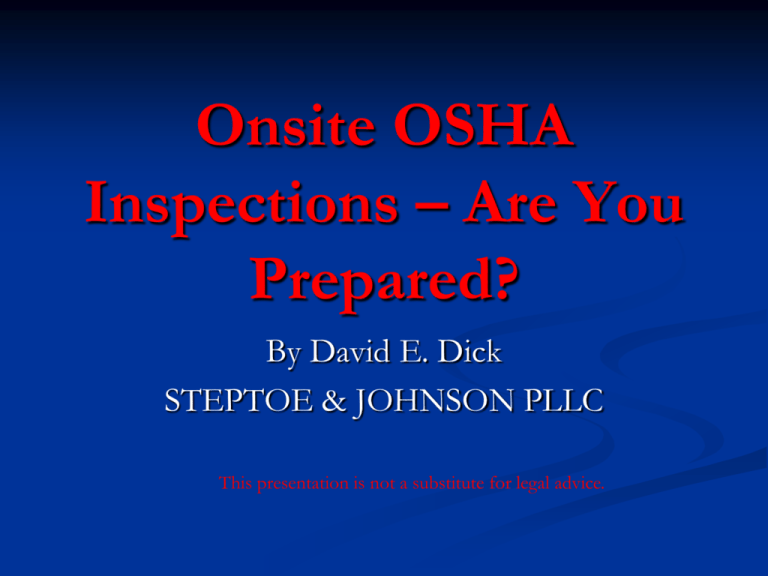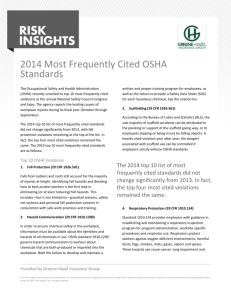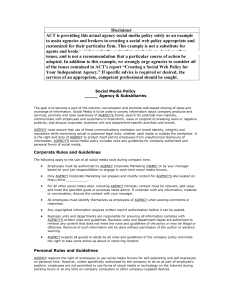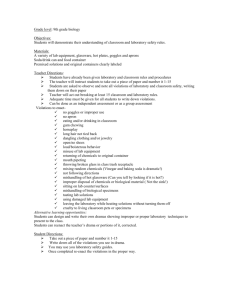Safety Slide Presentation
advertisement

Onsite OSHA Inspections – Are You Prepared? By David E. Dick STEPTOE & JOHNSON PLLC This presentation is not a substitute for legal advice. How Did They Find Me? Programmed Inspections Employee Complaints Drive By’s National Emphasis Programs Severe Violator Program Disputes with Unions Fatalities or Serious Accidents Current National and Local Emphasis Programs •Fall hazards (GI & Construction) •Powered industrial trucks •Amputation •Trenching & Excavation •Silica •Hexavalent Chromium They Found Me. Now What? Act like a duck – be calm on the surface but paddle like hell underneath. First things first: in or out? Warrant or not? It’s generally a good idea to be cooperative, unless you have good reason not to be. If the CSO does have a warrant, you still have rights, including: challenging the warrant; trying to limit the inspection to the boundaries of the warrant. Be Cautious Check credentials. Ask the reason for the inspection and what type it is. If it is a complaint inspection, get a copy of the complaint. Don’t ask who filed it. Be careful not to volunteer information, no matter how nice the inspector may be. If the inspection is the result of a fatality, be aware that OSHA can file criminal charges. You can terminate an inspection you allowed without a warrant and insist on a warrant. Frequently Cited Standards Oil and Gas Field Services October 2011-September 2012 Condition of flexible cords Electrical equipment-suitable for location, listed and labeled Labeling of electrical boxes, disconnects Path to ground –continuous General Duty Clause - Section 5(a)(1) of the Occupational Safety and Health Act of 1970: The employer did not furnish employment and a place of employment which were free from recognized hazards that were causing or likely to cause death or serious physical harm to employees. Guarding Floor and Wall Openings (1910.23(a)(1)): Every stairway floor opening shall be guarded by a standard railing 1910.23(a)(3): Every hatchway and chute floor opening shall be guarded Hazard Communication (1910.1200 ) Written program MSDS/SDS Training of employees PPE (1910.132(d)(1)): The employer shall assess the workplace to determine if hazards are present, or are likely to be present, which necessitate the use of personal protective equipment (PPE) Permit Required Confined Spaces (1910.146(c)(1)): The employer shall evaluate the workplace to determine if any spaces are permit-required confined spaces Portable Fire Extinguishers (1910.157): Maintained in a fully charged and operable condition Training needs to be conducted on the fire extinguisher use and the hazards involved with incipient stage fire Respiratory Protection (1910.134): Written respiratory protection program –Selection –Medical evaluation –Fit-testing –Training What We’re Seeing Is Consistent June 13 - Texas oilfield services company faces $72,900 in penalties for 14 alleged safety and health workplace violations. PumpCo Energy Services Inc. was cited for failing to take effective measures to prevent employee entry into permitrequired confined spaces. OSHA's citation said the company sent employees into “sand kings”—large metal containers for storage of sand commonly used in hydraulic fracturing—without adequate confined-space safety training, exposing them to respiratory hazards. PumpCo was cited for two serious health violations, including failing to provide medical evaluations for workers required to wear respirators. OSHA also cited the company for allowing an employee to operate a crane without adequate training. 2013 - NorAm Drilling Co., Monahans, Texas is contesting a two-item serious citation and a penalty of $7,650, for alleged violations of 1910.303(b)(7)(i), for failure to ensure that unused openings in boxes, raceways, auxiliary gutters, cabinets, equipment cases, or housings were effectively closed to afford protection substantially equivalent to the wall of the equipment, and 1910.305(g)(2)(iii), for failure to ensure that flexible cords were connected to devices and fittings so that tension would not be transmitted to joints or terminal screws (13-0969). 2012 – Drilling company cited for (1) failure to guard edge of rig platform (allowing drop more than 7 feet ($2,800); (2) bench grinder wheel not guarded ($2,800); (3) diesel fuel pump not rated for outdoor use ($4,900); (4) improper retainer on electrical equipment; (5) fuel pump and generator were not marked with manufacturer name; (6) improperly repaired electrical line on fuel pump ($4,200); (there’s more……… (7) fuel pump not listed by accredited lab (like UL) ($4,200); (8) GFCI did not trip when tested ($2, 800); (9) two branch circuits fed into one breaker ($2,800); (10) electrical conductors spliced with tape instead of proper terminal connectors ($4,900); (11) failure to label circuit breakers ($2,800); (12) missing grounding pin ($4,900); (13) no strain relief ($2,800); (14) unused opening in electrical box exposed ($4,900); there’s more………. (15) damaged and missing receptacle cover (3,500); (16) improper grounding of generator ($4,900); (17) electrical extension cord powering a pump run through a wall and wooden floor ($0). Typical HAZCOM Violations: Failure to prove training took place No written program Failure to produce MSDS Failure to identify all chemicals used Incomplete training (what, where, when, how to recognize, specifics of program) Typical Fall Protection Violations No written PPE assessment No certified PPE assessment Failure to inspect or properly maintain PPE (lanyards) Failure to require use (working at heights) Failure to train, or no written proof of training Failure to guard roof edges TYPICAL ELECTRICAL STANDARD VIOLATIONS Blocked electrical cabinets Open circuit boxes Reverse polarization Switch plates or covers cracked or missing Open holes in circuit boxes Failure to use GFCI’s Dust accumulation on electrical boxes Ground prongs missing Improper use of extension cords Temporary wiring instead of fixed wiring (fans, lights, etc.) TYPICAL INDUSTRIAL TRUCK VIOLATIONS Documentation of training (certified), and re-training as necessary Routine inspections prior to use Trucks in disrepair (seatbelts, horns, lights) Lifting employees on forks without proper precautions, lanyards, etc. Failure to train Unstable loads Failure to prove pre-shift inspection, or tagging out of service Typical LOTO Violations Inadequate training or program Failure to recognize application (un-jamming equipment, crawling on machinery, etc.) Failure to require use (usually followed by traumatic event) Failure to prove audit, or certify it No machine specific procedures No process in place for use of contractors Typical Ladder Violations Ladders not proper for job (electrical) Fixed ladders not extending beyond floor or roof Failure to inspect or tag out of service Failure to tie off ladders Rungs not free of grease and oil Failure to ensure adequate clearances on fixed ladders What to Expect in the Citation Process Initial penalties double what OSHA might otherwise settle for. Predominantly serious violations, but willful anytime there is a fatality. Grouping of like violations. How Penalties are Determined Four factors: gravity, size, good faith and history Gravity determined by severity and probability Discounts for size (60%), good faith (25%) and history (10%) All this is hidden from view Instance by instance violations, if egregious All subject to negotiations Implications of Contesting or Accepting OSHA Citations When Accepting: Sets up repeat violations at all locations for the next five years Increases risks of willful violations Provides excellent fodder for deliberate intent lawsuits More likely to invite future inspections For some employers, can prevent the attainment of future business Abatement costs Implications of Contesting or Accepting OSHA Citations When Contesting Requires a lot more than just negotiating the penalty amount Costly process best left to professionals, depending on the stakes Can take years to run its course Lets OSHA know you are not to be taken lightly How to Improve Your Odds in the Citation Process Never get there in the first place – have a well executed safety program Audit, audit, audit – but beware the double edged sword Enforce safety and health rules – discipline employees Be prepared for an OSHA inspection Prior to the informal conference, do your homework – first impressions are important Make a strong technical argument, and trot out any affirmative defenses If you’re willing to spend the money, don’t be afraid to contest – it is a tactical game In the Almost Immortal Words of Kenny Rogers You’ve got to know when to hold’em; Know when to fold’em; Know when to walk away; Know when to run; Never count your money while you’re sitting at the table; There’ll be time enough for countin’, when the dealin’s done.





